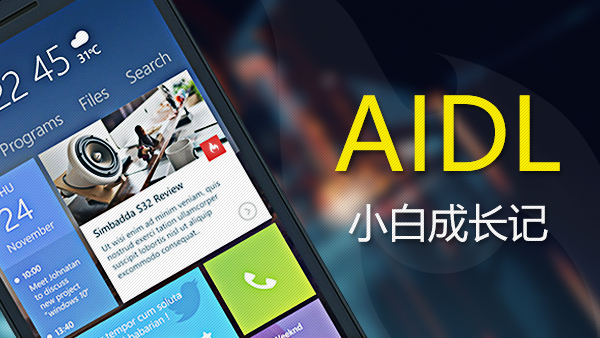二、Volley源码解析
2.1 Volley框架结构
根据Volley的框架结构,在上一章可以看出所有的Request请求都是按照这个流程处理,那么我将从请求流程进行源代码分析.
其框架主要分为3部分:
(1)Main Thread中创建Request以及解析显示请求返回结果;
(2)Cache Thread在Cache中处理请求,若请求的内容在缓存中已存在,则从缓存中取出并返回;
(3)NetWork Thread,当请求在缓存中找不到时,则需要从访问网络获取数据.
主线程和Cache线程都只有一个,而NetWork Thread线程可以有很多个(默认是4个),这样能够解决并行问题.
2.2 Volley之RequestQueue
RequestQueue请求队列作为Volley框架使用过程第一个需要创建目标,其内部通过调用Volley类的静态函数进行创建.
1 2 3 4 5 6 7 8 9 10 | public static RequestQueue newRequestQueue(Context context, HttpStack stack, int maxDiskCacheBytes) { File cacheDir = new File(context.getCacheDir(), DEFAULT_CACHE_DIR) ...//省略代码:主要内容 //1、创建UserAgent用来封装应用的包名跟版本号,提供给服务器 //2、根据当前系统的版本号来选择HttpStack,若版本大于等于9(Android 2.2以上),使用HttpURLConnection,所以使用一个HurlStack;若小于9,则使用HttpClient. //3、创建一个NetWork,调用其构造函数并传入参数stack,去跟网络进行通信. //4、创建一个DiskBasedCache对象,和Network一起,传给RequestQueue作为参数,创建RequestQueue对象. RequestQueue queue = new RequestQueue(new DiskBasedCache(cacheDir), network);//创建RequestQueue queue.start();//调用RequestQueue的start方法 } |
请求队列作为Volley中所有请求的存储器,其内部使用Set集合来存储创建的Request,所有在队列中或者正在被处理的请求都会在这个集合中.
private final Set<request> mCurrentRequests = new HashSet<request>();
通过Volley的静态函数调用RequestQueue的构造函数创建RequestQueue对象:
</request</request
1 2 3 4 5 6 7 8 9 10 11 12 13 14 | public RequestQueue(Cache cache, Network network, int threadPoolSize, ResponseDelivery delivery) { mCache = cache;//缓存 mNetwork = network;//网络 mDispatchers = new NetworkDispatcher[threadPoolSize];//网络访问线程池 mDelivery = delivery;//派送Response的结果给主线程 } public RequestQueue(Cache cache, Network network, int threadPoolSize) { this(cache, network, threadPoolSize, new ExecutorDelivery(new Handler(Looper.getMainLooper()))); } public RequestQueue(Cache cache, Network network) { this(cache, network, DEFAULT_NETWORK_THREAD_POOL_SIZE);//默认DEFAULT_NETWORK_THREAD_POOL_SIZE=4 } |
其主要工作有:初始化Disk Cache缓存路径、执行网络请求接口NetWork、网络请求调度器NetworkDispatcher和请求结果派送者ResponseDelivery.
在上述创建过程中,无论是CacheDispatcher还是NetworkDispatcher都是继承至Thread.
1 2 3 4 5 6 | public class NetworkDispatcher extends Thread { ...//省略代码 } public class CacheDispatcher extends Thread { ...//省略代码 } |
ResponseDelivery其实是一个接口,其具体实现类似ExecutorDelivery,其构造函数的参数是一个Handler,而Handler的构造函数参数则是Lopper.getMainLooper(),所以这里其实是应用的主线程Looper,也就是说handler其实就是主线的Handler,其作用就是将请求的结果(正确的或者错误的)传输给主线程.
1 2 3 4 5 6 7 8 9 10 11 12 13 14 15 16 17 18 19 20 21 22 | /** * Delivers responses and errors. */ public class ExecutorDelivery implements ResponseDelivery { /** Used for posting responses, typically to the main thread. */ private final Executor mResponsePoster; /** * Creates a new response delivery interface. * @param handler {@link Handler} to post responses on */ public ExecutorDelivery(final Handler handler) { // Make an Executor that just wraps the handler. mResponsePoster = new Executor() { @Override public void execute(Runnable command) { handler.post(command); } }; } ...//省略代码 } |
在创建完成RequestQueue对象之后会调用start方法启动所有的dispatcher(CacheDispatcher和NetworkDispatcher):
1 2 3 4 5 6 7 8 9 10 11 12 13 14 15 16 17 | /** * start方法的作用就是启动所有的dispatcher(CacheDispatcher和NetworkDispatcher) */ public void start() { stop(); //保证当前所有的正在运行的Dispatcher都停止 //创建缓存的调度器(也是一个线程),并启动线程 mCacheDispatcher = new CacheDispatcher(mCacheQueue, mNetworkQueue, mCache, mDelivery); mCacheDispatcher.start(); //根据线程池的大小,创建相对应的NetworkDispatcher(线程),并启动所有的线程 for (int i = 0; i < mDispatchers.length; i++) { NetworkDispatcher networkDispatcher = new NetworkDispatcher(mNetworkQueue, mNetwork, mCache, mDelivery); mDispatchers[i] = networkDispatcher; networkDispatcher.start(); } } |
对应start方法当然就有stop方法,用于停止cache and network dispatchers:
1 2 3 4 5 6 7 8 9 10 | public void stop() { if (mCacheDispatcher != null) { mCacheDispatcher.quit(); } for (int i = 0; i < mDispatchers.length; i++) { if (mDispatchers[i] != null) { mDispatchers[i].quit(); } } } |
在start过程中,出现mCacheQueue, mNetworkQueue,这两个的定义如下:
1 2 3 4 5 6 7 | //带有优先级cache请求队列 private final PriorityBlockingQueue<Request<?>> mCacheQueue = new PriorityBlockingQueue<Request<?>>(); /** The queue of requests that are actually going out to the network. */ private final PriorityBlockingQueue<Request<?>> mNetworkQueue = new PriorityBlockingQueue<Request<?>>(); |
可以看到它们其实都是Java并发(Concurrent)包中提供的利用优先级来执行的阻塞队列PriorityBlockingQueue.显然它们就应该是用来放置从外面传进来的请求,比如JsonRequest,ImageRequest和 StringRequest.
在上述分析了怎么启动怎么停止,那么当创建好Request对象时,怎么样才能添加到请求队列中呢?RequestQueue提供了一个add方法,用于将创建好的Request添加到请求队列中.并判断请求的是否存储于缓存中来进行分类.
1 2 3 4 5 6 7 8 9 10 11 12 13 14 15 16 17 18 19 20 21 22 23 24 25 26 27 28 29 30 31 32 33 34 35 36 37 38 39 | public <T> Request<T> add(Request<T> request) { // 将请求所在队列设置为当前队列,并将请求添加到mCurrentRequests中,表明是正在处理中,并且这里用synchronized来同步 request.setRequestQueue(this); synchronized (mCurrentRequests) { mCurrentRequests.add(request); } //在这里会设置序列号,保证每个请求都是按顺序被处理的。 request.setSequence(getSequenceNumber()); request.addMarker("add-to-queue"); // 如果这个请求是设置不缓存的,那么就会将其添加到mNetworkQueue中,直接去网络中获取数据 if (!request.shouldCache()) { mNetworkQueue.add(request); return request; } //到这里,表明这个请求可以去先去缓存中获取数据。 synchronized (mWaitingRequests) { String cacheKey = request.getCacheKey();//key是一个字符串,由Method + ":" + Url组成,默认是Url作为cacheKey if (mWaitingRequests.containsKey(cacheKey)) {. //如果这个请求已经有一个相同的请求(相同的CacheKey)在mWatingRequest中, //那么就要将相同CacheKey的请求用一个LinkedList给装起来,先不需要处理,等那个正在处理的请求结束后,再看看应该怎么处理 Queue<Request<?>> stagedRequests = mWaitingRequests.get(cacheKey); if (stagedRequests == null) { stagedRequests = new LinkedList<Request<?>>(); } stagedRequests.add(request); mWaitingRequests.put(cacheKey, stagedRequests); if (VolleyLog.DEBUG) { VolleyLog.v("Request for cacheKey=%s is in flight, putting on hold.", cacheKey); } } else { //如果mWaitingRequest中没有,那么就将其添加到集合中,将添加到mCacheQueue队列中,表明现在这个cacheKey的请求已经在处理了. mWaitingRequests.put(cacheKey, null); mCacheQueue.add(request); } return request; } } |
当mCacheQueue或者mNetworkQueue利用add方法添加请求之后,在运行的线程就会接收到请求,从而去处理相对应的请求,最后将处理的结果由mDelivery来发送到主线程进行更新.
当请求在缓存线程中或者是在网络线程中处理完成后,每个Request都会去调用对应的finish方法,
1 2 3 4 5 6 7 | void finish(final String tag) { if (mRequestQueue != null) { mRequestQueue.finish(this); onFinish(); } ...//省略代码 } |
下一步会调用RequestQueue的finish()方法:
1 2 3 4 5 6 7 8 9 10 11 12 13 14 15 16 17 18 19 20 21 22 23 24 25 26 27 | <T> void finish(Request<T> request) { //1、从当前队列中移除对应的请求 synchronized (mCurrentRequests) { mCurrentRequests.remove(request); } synchronized (mFinishedListeners) { for (RequestFinishedListener<T> listener : mFinishedListeners) { listener.onRequestFinished(request);//请求结束监听 } } //2-> if (request.shouldCache()) { synchronized (mWaitingRequests) { String cacheKey = request.getCacheKey(); Queue<Request<?>> waitingRequests = mWaitingRequests.remove(cacheKey); if (waitingRequests != null) { if (VolleyLog.DEBUG) { VolleyLog.v("Releasing %d waiting requests for cacheKey=%s.", waitingRequests.size(), cacheKey); } // Process all queued up requests. They won't be considered as in flight, but // that's not a problem as the cache has been primed by 'request'. mCacheQueue.addAll(waitingRequests); } } } } |
第2步中,就是判断这个请求有没有缓存,1)如果有,那么我们这个时候,将前面mWaitingQueue中相同CacheKey的一大批请求再扔到mCacheQueue中,为什么现在才扔呢?因为前面我们不知道相同CacheKey的那个请求到底在缓存中有没有;2)如果没有,它需要去网络中获取,那就等到它从网络中获取之后,放到缓存中后,它结束后且已经缓存了,这个时候,我们就可以保证后面那堆相同CacheKey的请求可以在缓存中去取到数据了,而不需要再去网络中获取了.
最后在RequestQueue中还提供了2个方法用于用户自己随时可控地取消请求:
1 2 3 4 5 6 7 8 9 10 11 12 13 14 15 16 17 18 19 20 21 22 23 24 25 | //根据顾虑规则进行请求的取消 public void cancelAll(RequestFilter filter) { synchronized (mCurrentRequests) { for (Request<?> request : mCurrentRequests) { if (filter.apply(request)) { request.cancel(); } } } } /** * 根据请求的Tag进行取消 */ public void cancelAll(final Object tag) { if (tag == null) { throw new IllegalArgumentException("Cannot cancelAll with a null tag"); } cancelAll(new RequestFilter() { @Override public boolean apply(Request<?> request) { return request.getTag() == tag; } }); } |
RequestFilter是RequestQueue的内部接口,没有具体实现,上面第二个cancleAll方法的过滤规则就是看Tag是否相等.
到此RequestQueue的源代码核心内容就已经分析完成了.
2.3 Volley之Request
Volley提供的Request有:StringRequest、JsonArrayRequest、JsonObjectRequest、ImageRequest和JsonRequest,其中JsonArrayRequest、JsonObjectRequest继承至JsonRequest,StringRequest、ImageRequest、JsonRequest继承至Request.Volley还可以自定义Request.
Request是一个抽象类.提供了很多的方法,子类需要实现的两个抽象方法为:
1 2 3 4 5 6 7 8 9 10 | /** 子类必须实现这个方法,用于将解析response后的数据传递给request的监听者,解析失败则不会传递. */ abstract protected void deliverResponse(T response); /** 子类必须实现该方法,用于解析网络请求返回结果response并返回一个恰当的response-type,这个方法将被一个工作线程调用. * @return The parsed response, or null in the case of an error */ abstract protected Response<T> parseNetworkResponse(NetworkResponse response); |
具体使用已在前一章讲过,无论是Volley中提供的request还是我们自定义的request,都会通过各自的解析方法解析自定义的数据.
2.4 HttpStack
前面准备了那么多,为了就是进行网络请求,那具体的网络请求是怎么样子的呢?
具体的网络请求实现是在HurlStack/HttpClientStack中实现的,还记得在Volley中创建请求队列时对当前系统版本进行判断,为了就是获取不同网络请求框架:
1 2 3 4 5 6 7 8 9 10 | if (stack == null) { if (Build.VERSION.SDK_INT >= 9) {//若版本大于9(Android2.3)则使用HurlStack,其中使用的是HttpURLConnection进行网络请求 stack = new HurlStack(); } else { ////若版本小于9(Android2.3)则使用HttpClientStack其中使用的是HttpClient进行网络请求 stack = new HttpClientStack(AndroidHttpClient.newInstance(userAgent)); } } //再通过NetWork类进行调用具体的网络请求实现类 Network network = new BasicNetwork(stack); |
其中NetWork是一个接口,它只包含一个方法: public NetworkResponse performRequest(Request<?> request) throws VolleyError;
其实现类就是BasicNetwork类,根据系统版本选择不同的网络请求框架并作为参数传入到BasicNetwork中.
1 2 3 4 5 6 7 8 9 10 11 12 13 14 15 16 | public BasicNetwork(HttpStack httpStack, ByteArrayPool pool) {//...省略代码} //具体网络请求实现调用 @Override public NetworkResponse performRequest(Request<?> request) throws VolleyError { long requestStart = SystemClock.elapsedRealtime(); //...省略代码 // 添加头部信息 Map<String, String> headers = new HashMap<String, String>(); addCacheHeaders(headers, request.getCacheEntry()); httpResponse = mHttpStack.performRequest(request, headers);//调用真正的网络请求类 //各种网络请求返回值判断 //结果返回没有出错的网络请求返回数据 return new NetworkResponse(statusCode, responseContents, responseHeaders, false, SystemClock.elapsedRealtime() - requestStart); } |
NetworkResponse相当于一个Bean,其作用是将网络请求返回的数据、各种状态码、请求消耗时间等进行封装.
2.5 NetworkDispatcher
网络请求了解了,那管理网络请求的线程呢?其实就是NetworkDispatcher,当用户提交request之后,若CacheDispatcher中没有对应的请求缓存,就必须要进行网络请求,那这时的就需要NetworkDispatcher线程来进行管理了.
1 2 3 4 5 6 7 8 9 10 11 12 13 14 15 16 17 18 19 20 21 22 23 24 25 26 27 28 29 30 31 32 33 34 35 36 37 38 39 40 41 42 43 44 45 46 47 48 49 50 51 52 53 54 55 56 57 58 59 60 61 62 63 64 65 | @Override public void run() { Process.setThreadPriority(Process.THREAD_PRIORITY_BACKGROUND); Request<?> request; while (true) { long startTimeMs = SystemClock.elapsedRealtime(); // release previous request object to avoid leaking request object when mQueue is drained. request = null; try { // 从队列中获取一个请求,若没有则一直阻塞 request = mQueue.take(); } catch (InterruptedException e) { // We may have been interrupted because it was time to quit. if (mQuit) { return; } continue; } try { request.addMarker("network-queue-take"); // 判断请求有没有取消,如果取消,则不必再继续 if (request.isCanceled()) { request.finish("network-discard-cancelled"); continue; } addTrafficStatsTag(request); // 调用mNetwork去跟网络打交道 NetworkResponse networkResponse = mNetwork.performRequest(request); request.addMarker("network-http-complete"); // 如果服务器返回一个未修改(304)的响应,并且这个请求已经发送过响应对象,不需要再继续,因为没改过 if (networkResponse.notModified && request.hasHadResponseDelivered()) { request.finish("not-modified"); continue; } // 解析响应的数据,返回Response对象 Response<?> response = request.parseNetworkResponse(networkResponse); request.addMarker("network-parse-complete"); // 根据request的shouldCache字段来判断是不是需要缓存,如果需要,则将其放到mCache中。 if (request.shouldCache() && response.cacheEntry != null) { mCache.put(request.getCacheKey(), response.cacheEntry); request.addMarker("network-cache-written"); } // 调用 mDelivery将Response对象传回主线程进行UI的更新。 request.markDelivered(); mDelivery.postResponse(request, response); } catch (VolleyError volleyError) { volleyError.setNetworkTimeMs(SystemClock.elapsedRealtime() - startTimeMs); parseAndDeliverNetworkError(request, volleyError); } catch (Exception e) { VolleyLog.e(e, "Unhandled exception %s", e.toString()); VolleyError volleyError = new VolleyError(e); volleyError.setNetworkTimeMs(SystemClock.elapsedRealtime() - startTimeMs); //有错误,也会调用到mDelivery,将错误信息传回到主线程,进行提示 mDelivery.postError(request, volleyError); } } } |
NetworkDispatcher线程主要完成了:
1) 调用 mQueue的take()方法从队列中获取请求,如果没有请求,则一直阻塞在那里等待,直到队列中有新的请求到来。
2) 判断请求有没有被取消,如果被取消,则重新获取请求。
3) 调用Network对象将请求发送到网络中,并返回一个 NetworkResponse对象。
4) 调用请求的pareseNetworkResonse方法,将NetworkResponse对象解析成相对应的Response对象。
5) 判断请求是否需要缓存,如果需要缓存,则将其Response中cacheEntry对象放到缓存mCache中。
6) 调用 mDelivery将Response对象传到主线程中进行UI更新。
Volley框架中主要的类和流程就如上面所述,其中还有很多小细节没有描述,但是根据Volley使用的流程完全能够看得懂其源代码.

 随时随地看视频
随时随地看视频




